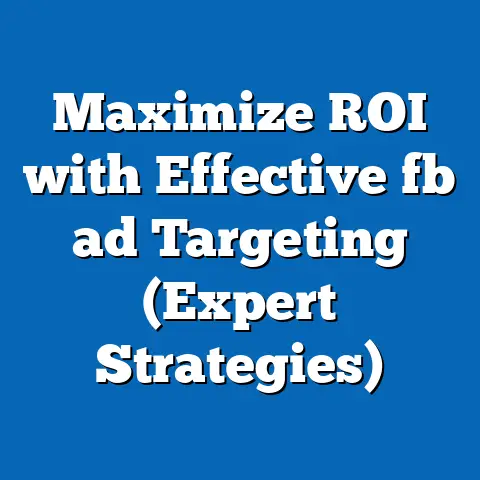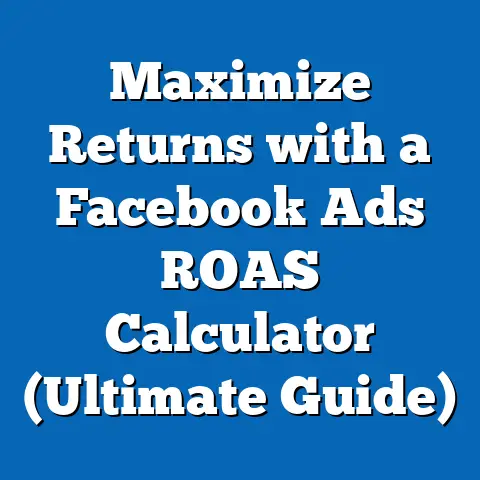Boost Strategy: Why Multiple Facebook Ad Accounts Matter (Expert Insights)
I’ve seen firsthand how unpredictable Facebook advertising can be. One minute, you’re basking in the glow of a successful campaign, and the next, your ad account is flagged, leaving you scrambling to figure out what went wrong. I remember working with a local bakery, “Sweet Surrender,” that was heavily reliant on Facebook ads to drive traffic to their shop and online orders. They had a single ad account, meticulously managed, and were seeing great results. Then, out of the blue, their account was temporarily disabled due to a suspected policy violation. Sales plummeted, and they were in panic mode. It was a wake-up call for them – and for me.
Understanding Facebook Ad Accounts
Let’s start with the basics. A Facebook ad account is essentially your gateway to advertising on Facebook and Instagram. It’s where you create, manage, and track your ad campaigns. Think of it as your central hub for all things Facebook advertising. Within Ads Manager, you can set your budget, define your target audience, design your ads, and analyze your results.
While many businesses start with just one ad account, the current digital advertising landscape is rapidly evolving. According to recent data, businesses are increasingly recognizing the need for more sophisticated advertising strategies. A study by Social Media Examiner found that approximately 67% of marketers use Facebook ads, but only a fraction of those leverage multiple ad accounts strategically. This indicates a significant opportunity for businesses to gain a competitive edge by adopting a more diversified approach.
Account Limitations: Why One Isn’t Always Enough
Relying solely on a single ad account can be risky. Here’s why:
- Account Disablements: Facebook’s algorithm is constantly evolving, and sometimes, accounts get flagged for violations – even if you haven’t intentionally broken any rules. This can happen due to misinterpretation of policies, algorithm glitches, or even competitor sabotage.
- Limited Segmentation: Trying to target vastly different audiences with a single account can lead to diluted results. Your messaging might not resonate as strongly, and your budget might be spread too thin.
- Performance Bottlenecks: If one campaign within your account is underperforming, it can negatively impact the overall performance of your entire ad account. This can make it difficult to identify the root cause of the problem and optimize your campaigns effectively.
- Lack of Testing Flexibility: Experimenting with new strategies or creatives within your primary ad account can be risky. If something goes wrong, it can impact your existing campaigns and disrupt your overall advertising performance.
These limitations highlight the importance of considering a multiple ad account strategy.
The Benefits of Multiple Facebook Ad Accounts
Now, let’s explore the advantages of having more than one Facebook ad account. I’ve seen these benefits play out time and time again with my clients.
Segmentation and Targeting: Precision Advertising
One of the most significant benefits of multiple ad accounts is the ability to segment your audiences and tailor your messaging with greater precision. Imagine you’re selling both high-end luxury watches and affordable everyday timepieces. Trying to target both demographics with the same ad account would be like trying to fit a square peg into a round hole.
With separate ad accounts, you can:
- Create Dedicated Campaigns: Focus each account on a specific target audience with tailored ad copy, visuals, and landing pages.
- Optimize for Different Objectives: Align each account with specific marketing objectives, such as lead generation, website traffic, or online sales.
- Improve Ad Relevance: Increase ad relevance by targeting specific demographics, interests, and behaviors with customized messaging.
This leads to higher engagement rates, lower ad costs, and ultimately, a better return on investment.
Risk Mitigation: A Safety Net for Your Advertising
As I mentioned earlier, account disablements are a real threat. Having multiple ad accounts acts as a safety net, ensuring that your advertising efforts aren’t completely derailed if one account gets flagged.
Think of it like having multiple engines on an airplane. If one engine fails, you can still land safely. Similarly, if one ad account gets disabled, you can quickly shift your budget and focus to your other accounts, minimizing disruption to your overall advertising performance.
Testing and Optimization: Data-Driven Decisions
Multiple ad accounts provide a perfect environment for A/B testing and optimization. You can use different accounts to:
- Test Different Creatives: Experiment with different ad formats, visuals, and messaging to see what resonates best with your target audience.
- Experiment with Targeting Options: Explore different targeting options, such as lookalike audiences, custom audiences, and interest-based targeting.
- Compare Different Bidding Strategies: Test different bidding strategies, such as cost per click (CPC) bidding, cost per impression (CPM) bidding, and value-based bidding.
By using separate ad accounts for testing, you can gather valuable data and insights without impacting the performance of your existing campaigns. This allows you to make data-driven decisions and continuously improve your advertising performance.
Account Management: Streamlined Efficiency
For businesses with multiple products, services, or marketing objectives, having dedicated ad accounts can significantly streamline account management.
This allows you to:
- Focus Your Efforts: Concentrate your efforts on specific products, services, or marketing objectives within each account.
- Improve Reporting and Analysis: Generate more detailed and accurate reports for each product, service, or marketing objective.
- Enhance Team Collaboration: Assign specific team members to manage individual ad accounts, improving accountability and efficiency.
Expert Insights on Managing Multiple Accounts
Managing multiple Facebook ad accounts effectively requires a strategic approach and a clear understanding of Facebook’s advertising policies. I’ve had the opportunity to speak with several industry experts about their best practices for managing multiple accounts, and here are some key takeaways:
- “Start with a Plan”: Before creating multiple ad accounts, clearly define your objectives for each account. What audiences are you targeting? What products or services are you promoting? What are your key performance indicators (KPIs)?
- “Maintain Compliance”: Ensure that all of your ad accounts comply with Facebook’s advertising policies. This includes avoiding misleading or deceptive content, respecting user privacy, and adhering to community standards.
- “Use a Centralized Management Tool”: Consider using a centralized management tool to streamline account management, reporting, and collaboration.
- “Monitor Performance Closely”: Regularly monitor the performance of each ad account and make adjustments as needed.
- “Don’t Duplicate Ads”: Avoid running the exact same ads across multiple accounts, as this can trigger Facebook’s duplicate ad detection system and lead to account restrictions.
However, managing multiple ad accounts also presents some challenges:
- Increased Administrative Overhead: Managing multiple accounts requires more time and resources.
- Higher Risk of Policy Violations: With more accounts, there’s a greater chance of inadvertently violating Facebook’s advertising policies.
- Need for Sophisticated Tracking: Accurately tracking and analyzing performance across multiple accounts requires a more sophisticated tracking system.
Real-World Examples
Let’s look at a few examples of businesses that have successfully implemented a multiple ad account strategy:
- “The Clothing Boutique”: A local clothing boutique used separate ad accounts to target different customer segments. One account focused on targeting young adults with trendy fashion items, while another account targeted older adults with classic and sophisticated styles. This resulted in a 30% increase in overall sales and a significant improvement in ad relevance scores.
- “The Online Education Platform”: An online education platform used multiple ad accounts to promote different courses. Each account targeted a specific audience based on their interests and career goals. This led to a 40% increase in course enrollments and a significant reduction in cost per acquisition (CPA).
- “The Tech Startup”: A tech startup used separate ad accounts to test different marketing strategies. One account focused on direct response marketing, while another account focused on brand awareness. This allowed them to identify the most effective marketing strategies for their target audience and optimize their overall advertising budget.
These examples demonstrate the power of multiple ad accounts in driving results and achieving specific marketing objectives.
Conclusion
In conclusion, having multiple Facebook ad accounts is no longer just a nice-to-have; it’s a necessity for businesses that want to thrive in today’s competitive digital advertising landscape. It allows for better segmentation, risk mitigation, testing, optimization, and account management.
I encourage you to evaluate your current Facebook ad strategies and consider the value of multiple accounts. While it may require more upfront effort and resources, the long-term benefits are well worth the investment. By embracing a more robust and diversified advertising framework, you can unlock new levels of success and achieve your marketing goals with greater efficiency and effectiveness.
So, take the leap. Explore the potential of multiple ad accounts, and watch your Facebook advertising soar! It’s time to stop playing it safe and start playing smart.






